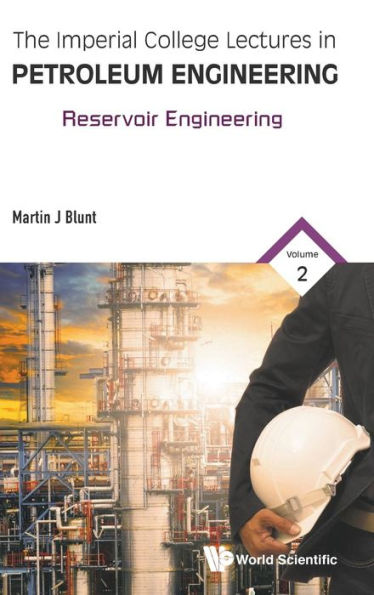Table of Contents
Preface v
About the Author vii
Chapter 1 Introduction to Reservoir Engineering 1
1.1 The Three Main Concepts: Material Balance, Darcy's Law and Data Integration 1
1.2 What is a Reservoir and What is a Porous Medium? 2
1.3 Fluid Pressures 3
1.4 Oil Initially in Place 5
1.4.1 Definition of Porosity and Saturation 6
1.4.2 Conversion From Reservoir to Surface Volumes 7
1.5 Oil Production 8
1.6 The World's Largest Oil Fields 10
1.7 Fluid Pressure Regimes 19
1.8 Reservoir Fluids 23
1.9 Phase Behaviour 29
Chapter 2 Material Balance 35
2.1 Material Balance for Gas Reservoirs 37
2.1.1 Connate Water and Pore Volume Compressibility 41
2.1.2 Water Drive Gas Reservoirs 44
2.1.3 Simple Aquifer Model 46
2.1.4 Aquifer Fitting 47
2.1.5 Impact of Residual Gas and Final Recovery 49
2.2 Material Balance for Oil Reservoirs 51
2.2.1 Production Above the Bubble Point 56
2.2.2 Solution Gas Drive 60
2.2.3 Gas Cap Drive 63
2.2.4 Natural Water Drive 66
2.2.5 Compaction Drive 66
2.2.6 Rate Dependence 67
2.2.7 Recap of Material Balance 68
Chapter 3 Decline Curve Analysis 69
3.1 Exponential Decline 70
3.2 Hyperbolic Decline 70
Chapter 4 Multiple Phases in Equilibrium 73
4.1 Young-Laplace Equation 73
4.2 Equilibrium at a Line of Contact 74
4.3 Spreading Coefficient 75
4.4 Two Fluids in A Capillary Tube 76
4.5 Wettability 78
4.5.1 Wettability Alteration 78
4.5.2 Contact Angle Hysteresis 79
Chapter 5 Porous Media 83
5.1 X-ray Imaging 83
5.2 Electron Microscopy to Image Micro-porosity 88
5.3 Topologically Representative Networks 89
Chapter 6 Primary Drainage 91
6.1 Typical Values of the Capillary Pressure 93
6.2 How is Capillary Pressure Measured? 93
Chapter 7 Imbibition 99
7.1 Pore-scale Displacement, Trapping of the Non-wetting Phase and Snap-off 100
7.2 Pore-scale Images of Trapped Phases 103
7.3 Typical Capillary Pressure Curves and Secondary Drainage 104
7.4 Different Displacement Paths and Trapping Curves 107
Chapter 8 Leverett J-function 113
8.1 Capillary Pressure and Pore Size Distribution 115
Chapter 9 Displacement Processes in Mixed-wet Media 121
9.1 Oil Layers 121
9.2 Effect of Wettability on Capillary Pressure 123
9.2.1 Weakly Water-wet Media 123
9.2.2 Capillary Pressures for Mixed-wet Media 124
9.2.3 Oil-wet Systems 126
9.3 Trapping Curves in Mixed-wet Systems 126
9.4 Transition Zones 127
9.5 Amott Wettability Indices 130
9.6 Example Exercises 131
Chapter 10 Fluid Flow and Darcy's Law 133
10.1 Stokes Flow 133
10.2 Reynolds Number and Flow Fields 135
10.3 Averaged Behaviour and Darcy's Law 136
10.4 Other Ways to Write Darcy's Law and Hydraulic Conductivity 142
10.5 Units of Permeability and the Definition of the Darcy 143
10.6 Definition of Flow Speed and Porosity 144
10.7 Estimating Permeability 145
10.8 Example Problem in Calculating Permeability 147
Chapter 11 Molecular Diffusion and Concentration 149
Chapter 12 Conservation Equation for Single-phase Flow 153
12.1 Analytical Solution of the Advection-diffusion Equation 158
12.2 Diffusion and Dispersion 160
Chapter 13 Capillary and Bond Numbers 167
Chapter 14 Relative Permeability 171
14.1 Relative Permeabilities for Sandstones and Predictions Using Pore-scale Modelling 174
14.1.1 Effect of Wettability in Sandstones 176
14.2 Imbibition and Oil Recovery Processes 179
14.3 Analysis of Relative Permeability in Mixed-wet Carbonates 185
14.3.1 Pore Structure and Connectivity 185
14.3.2 Effect of Fractional Wettability on Relative Permeability 191
14.4 Comparison of Network Model Results with Experimental Data 198
14.5 Impact of Relative Permeability on Field-scale Recovery 203
Chapter 15 Three-phase Flow 211
15.1 Spreading, Wetting and Oil Layers 211
15.2 Three-phase Relative Permeability and Trapped Saturations 218
15.3 Relative Permeability Predictions Using Pore-scale Modelling 222
15.4 Layer Drainage and Wettability 222
15.5 Why Ducks Don't Get Wet 224
Chapter 16 Conservation Equation for Multiphase Flow 227
16.1 ID Flow 227
16.1.1 Fractional Flow 230
16.1.2 Note About Nomenclature 230
16.2 Richards Equation 230
Chapter 17 Fractional Flow and Analytic Solutions 233
17.1 Buekley-Leverett Solution 238
17.2 Shocks 241
17.3 Welge Construction 243
17.4 Wave, Particle Speeds and Definitions 245
17.5 Effect of Gravity 247
17.6 Average Saturation and Recovery 248
17.7 Oil Recovery and the Impact of Wettability 254
Chapter 18 Analytic Solutions for Spontaneous Imbibition 257
18.1 Counter-current Imbibition 257
18.2 Extensions to Analytic Theory and Reservoir Simulation 264
Chapter 19 Bibliography and Further Reading 267
19.1 Relevant Research Papers and Other References 267
19.2 Papers from Imperial College 271
Chapter 20 Homework Problems 275
Chapter 21 Previous Exam Papers 281
21.1 Reservoir Engineering Examinations 281
21.2 Flow In Porous Media Questions 352
Index 385






